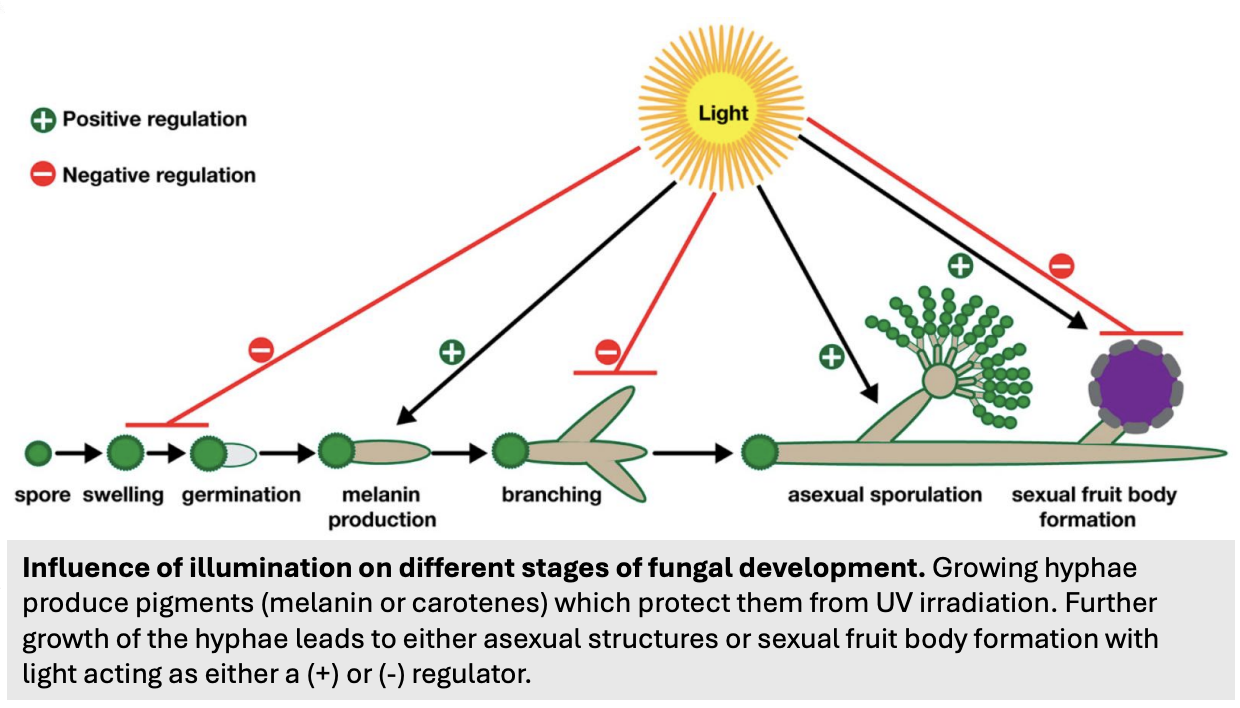MYCO 3.2 Secondary metabolites, Effects of environmental factors on fungal growth
1/83
There's no tags or description
Looks like no tags are added yet.
Name | Mastery | Learn | Test | Matching | Spaced |
|---|
No study sessions yet.
84 Terms
Fungi store energy in the form of _
slgt
Sugar alcohols, e.g., mannitol
Lipids
Glycogen
Trehalose
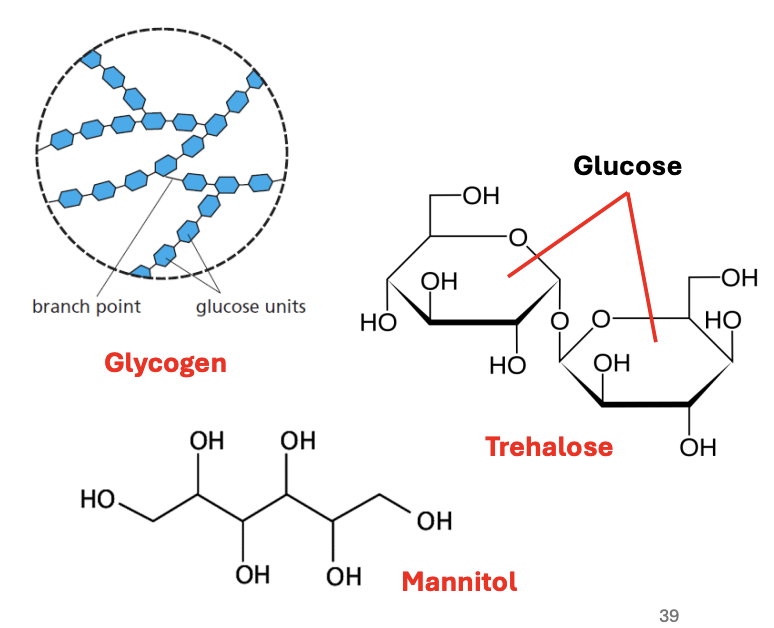
_ are set of metabolic activities not needed for normal growth
Secondary metabolism
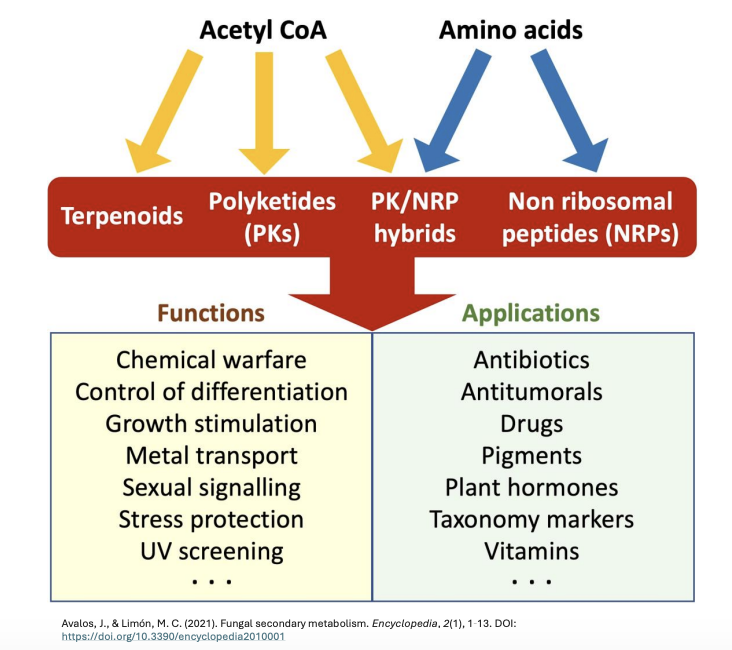
_ refers to a wide range of metabolic reactions whose products are not directly involved in normal growth
Secondary metabolism
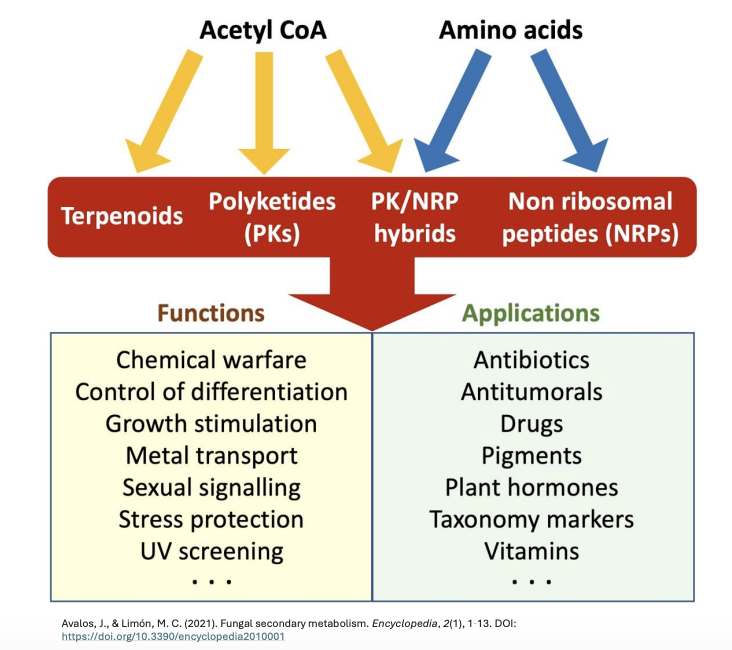
T/F: Secondary metabolites are of economic and environmental significance
TRUE
Enumerate 4 common features of secondary metabolites
ecng
Produced at the end of exponential growth or when growth is substrate-limited
bc they’re using up already all their materials or exploring other pathways that are less efficient
Produced from common metabolic intermediates but by specific enzyme pathways encoded by specific genes
A + B → C - - - > E (enzymatically created from D)
Not essential for normal growth/metabolism
Production is genus-, species-, strain-specific
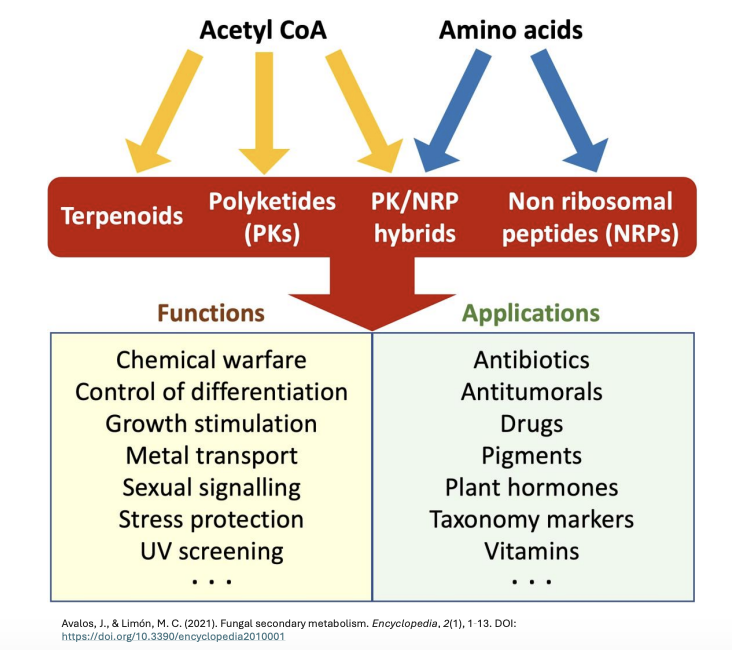
Explain 2 theories regarding secondary metabolism
Escape valve for metabolic byproducts via exportation out of cell, or
Accumulation of mostly inactive compounds
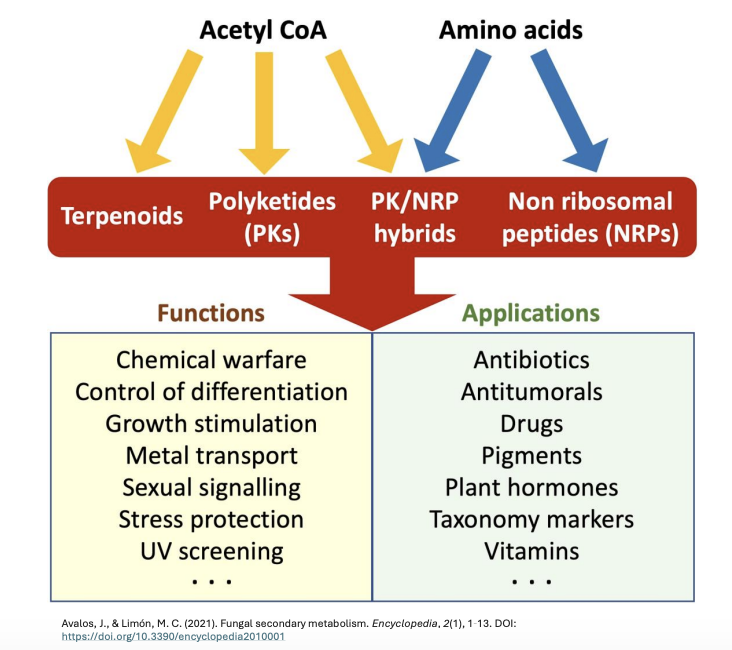
T/F: As you move from the oldest hyphae to newest hyphae, there is a difference in the storage form of the materials that the fungus is using
TRUE
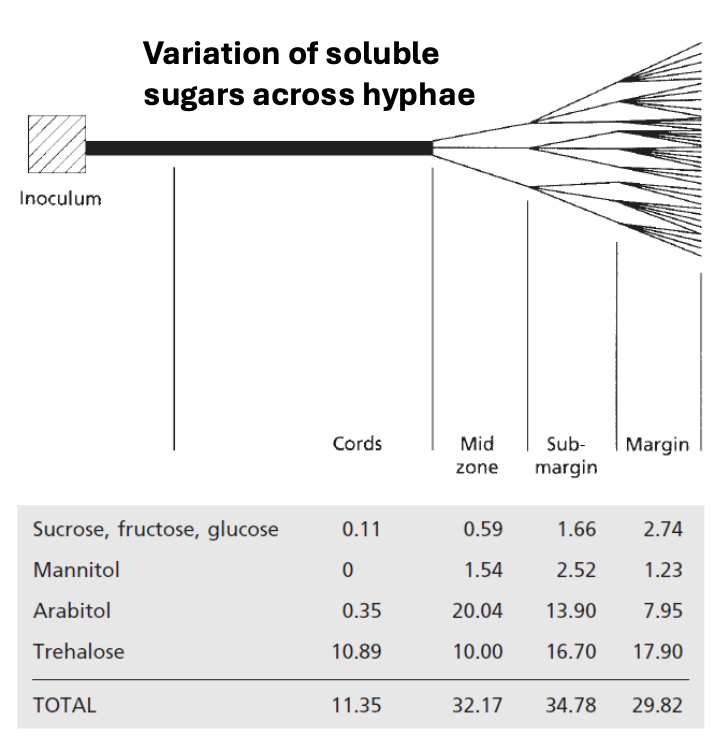
Closer to inoculum (older) parts, e.g., cords, would have zero _ but more _
0 mannitol
more trehalose
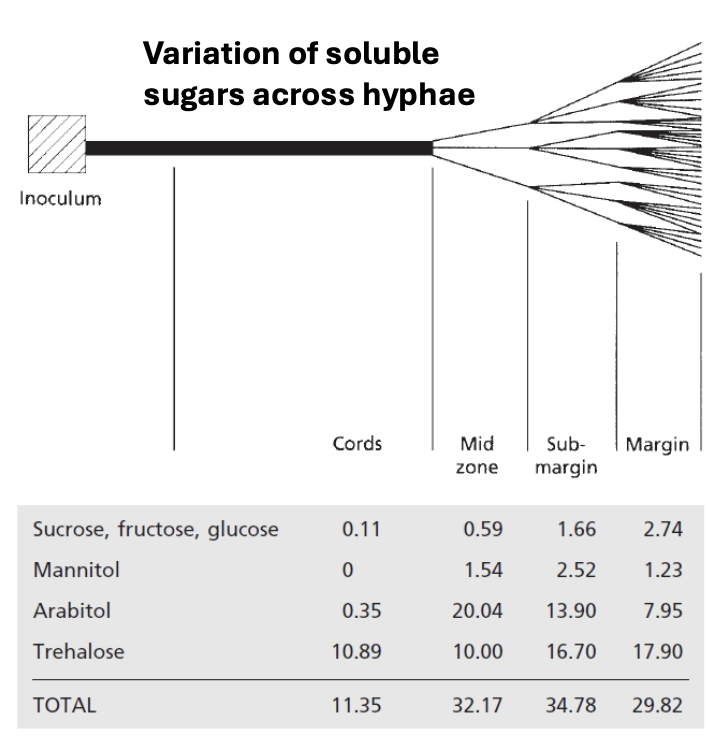
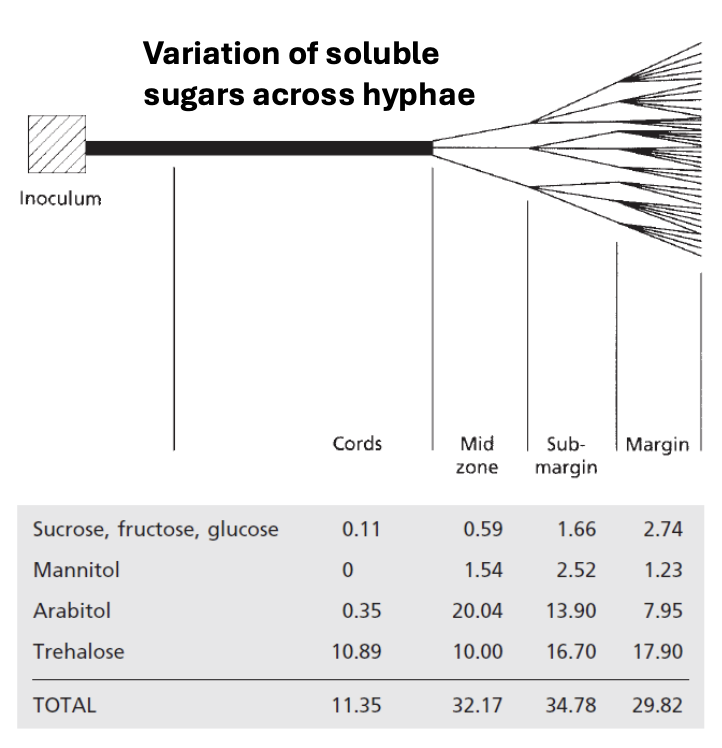
Explain variation in soluble sugars across hyphae
smat = Sucrose, Mannitol, Arabitol, Trehalose
It was observed that from oldest parts / closer to inoculum → cord to newer (farther) → margin, the relative ratios of storage forms remain the same, i.e., trehalose being highest and mannitol being lowest
Storage materials are higher in younger hyphae than in older hyphae because younger hyphae would have higher activity and thus higher accumulation of nutrients and materials
T/F: Storage materials are lower in younger hyphae than in older hyphae due to lower activity and thus lower accumulation of nutrients and materials
FALSE
Storage materials are higher in younger hyphae than in older hyphae due to higher activity and thus higher accumulation of nutrients and materials
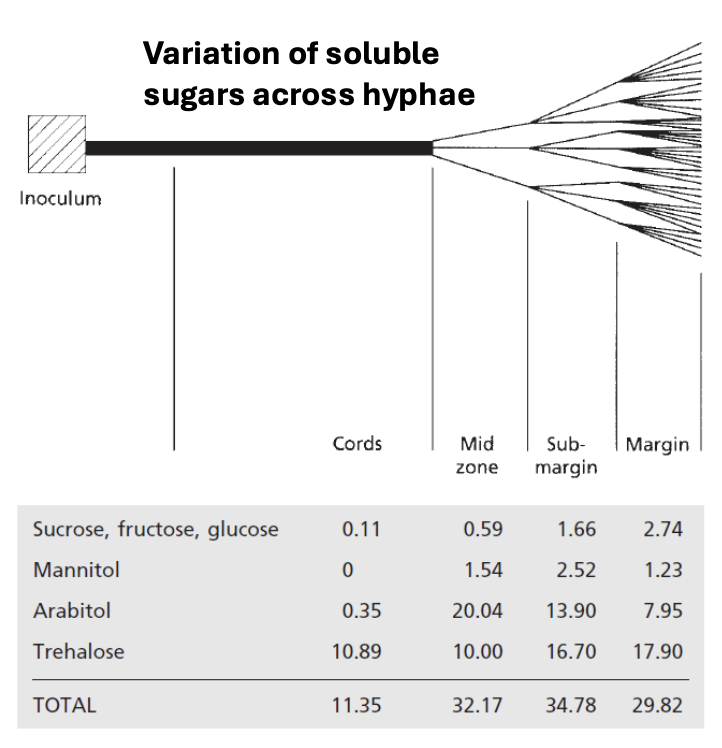
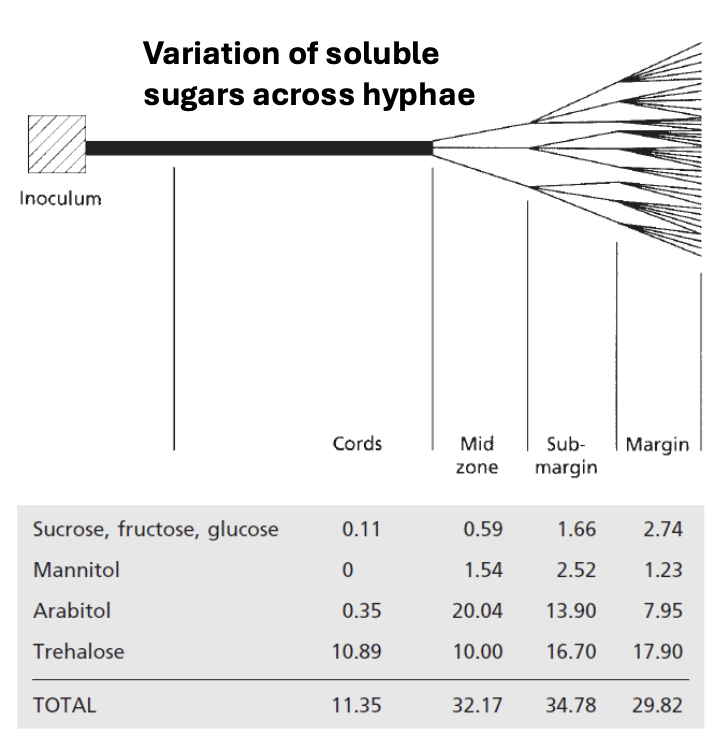
Submargin would have a higher total amount of storage materials than margin because _
Most likely, margin has the highest total amount, but because it is the most active, the margin is also using up its materials at a much higher rate compared to all the other zones/parts of hyphae, hence the slightly lower ratios in margin than in submargin (which is not as active as the former)
T/F: If fungus hits a wall, the amount of storage materials in margin could become higher or equal to that of submargin
TRUE
Bc rate of using up materials would slow down in margin zone
T/F: Where there’s more growth (in hyphae/reproductive structure), there would most likely be higher nutrient load
TRUE
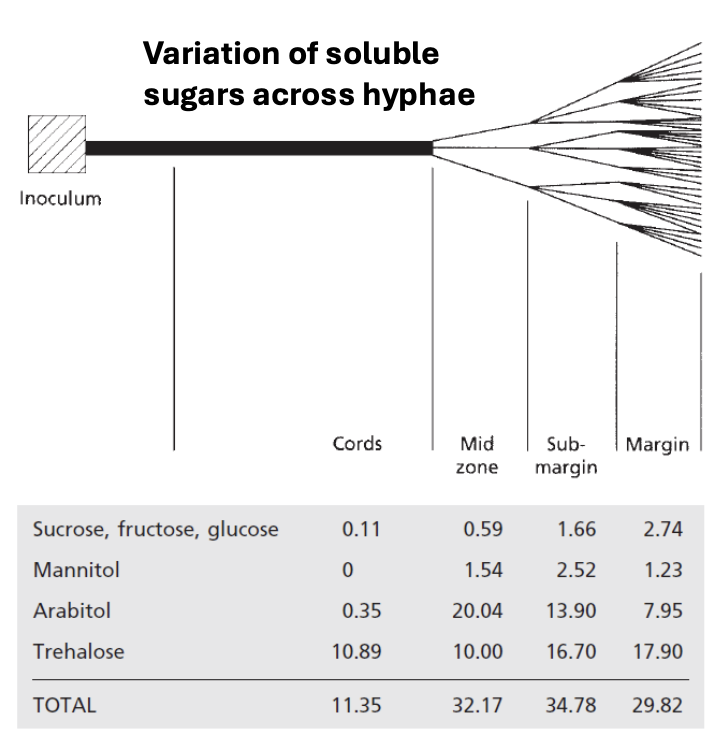
_ serve as precursors for secondary metabolites
4 main classes of secondary metabolites include _
Functions in nature and applications in industry:
Acetyl-CoA, Amino acids, or both
Terpenoids, Polyketides (PK), PK/NRP hybrids, Non-ribosomal peptides (NRP)
Nature = chemical warfare, control of differentiation, growth stimulation, sexual signaling, stress protection, UV screening cdgssu
Industrial = antibiotics, antitumoral, drugs, pigments, vitamins aadpv
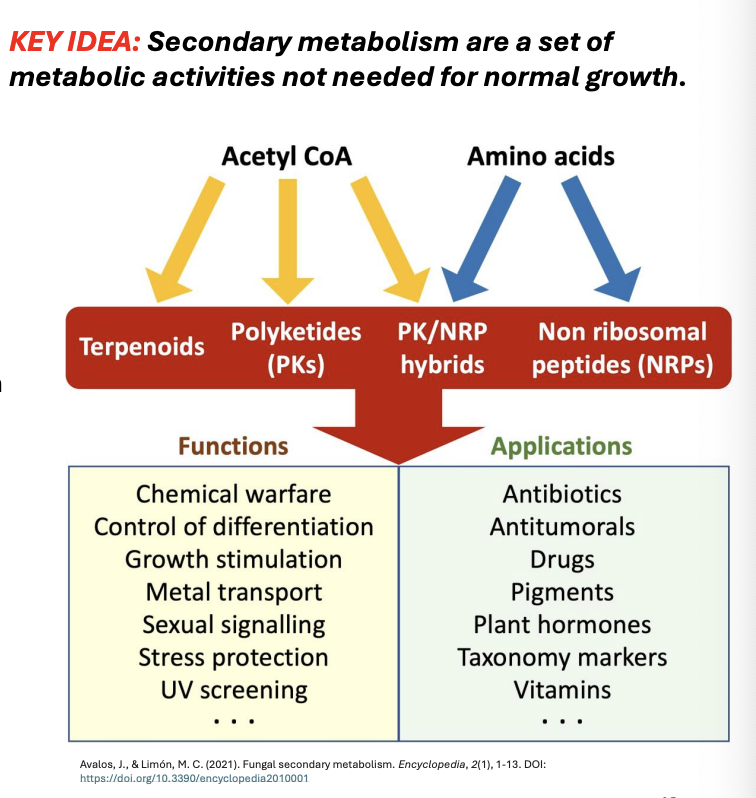
T/F: Fungi produce protective melanin from several types of secondary metabolites
TRUE
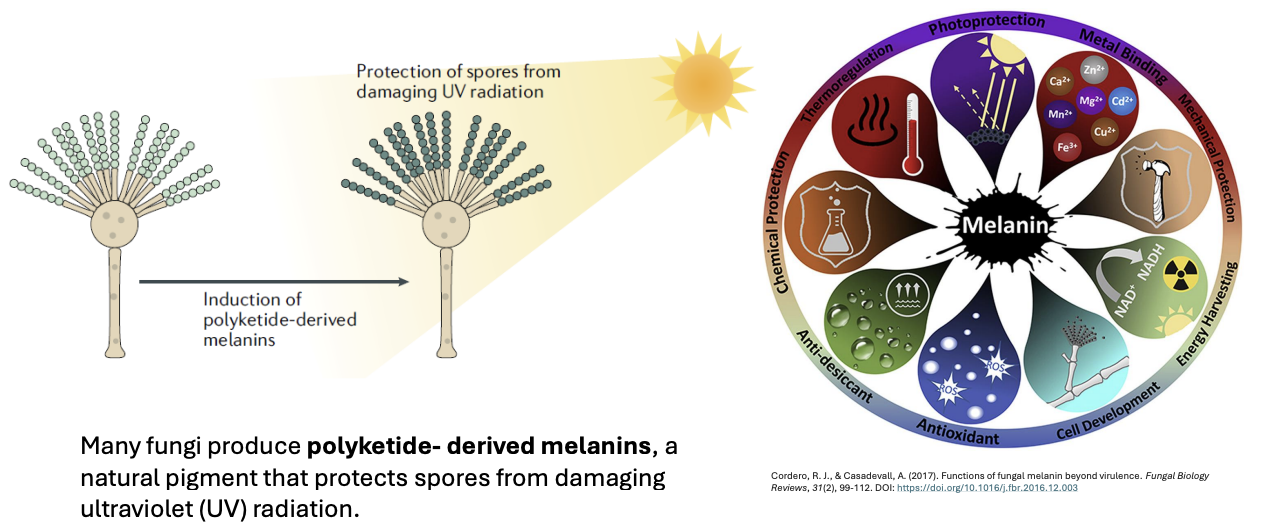
All fungi, at 1 point in their lives, would produce at least 1 kind of pigment—the most important of which is _
melanin
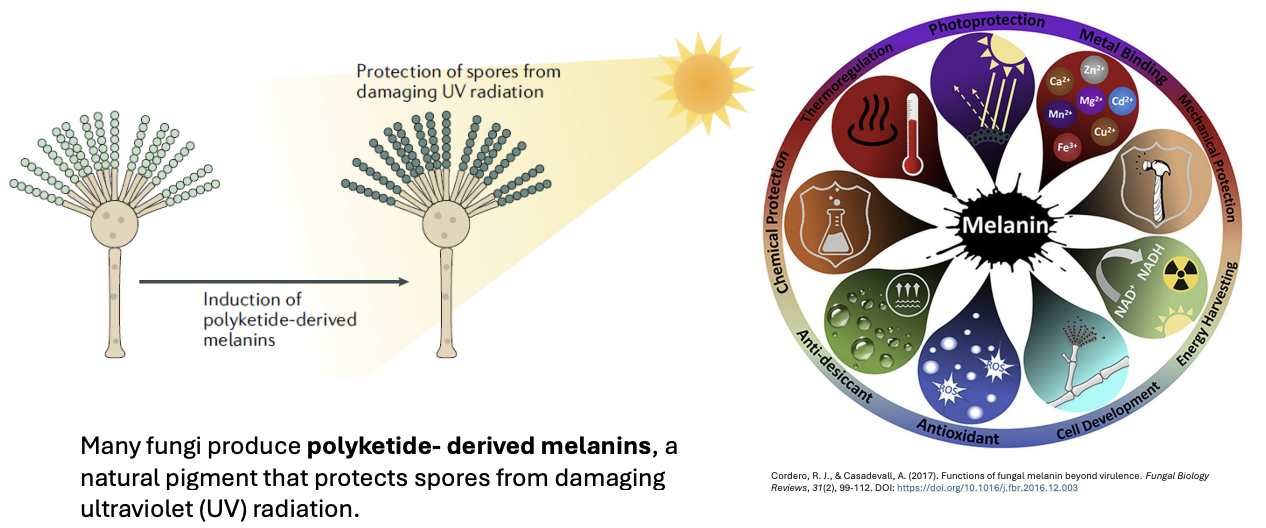
Many fungi produce _, a natural pigment that protects spores from damaging UV light
polyketide-derived melanin (PDM) from acetyl-CoA
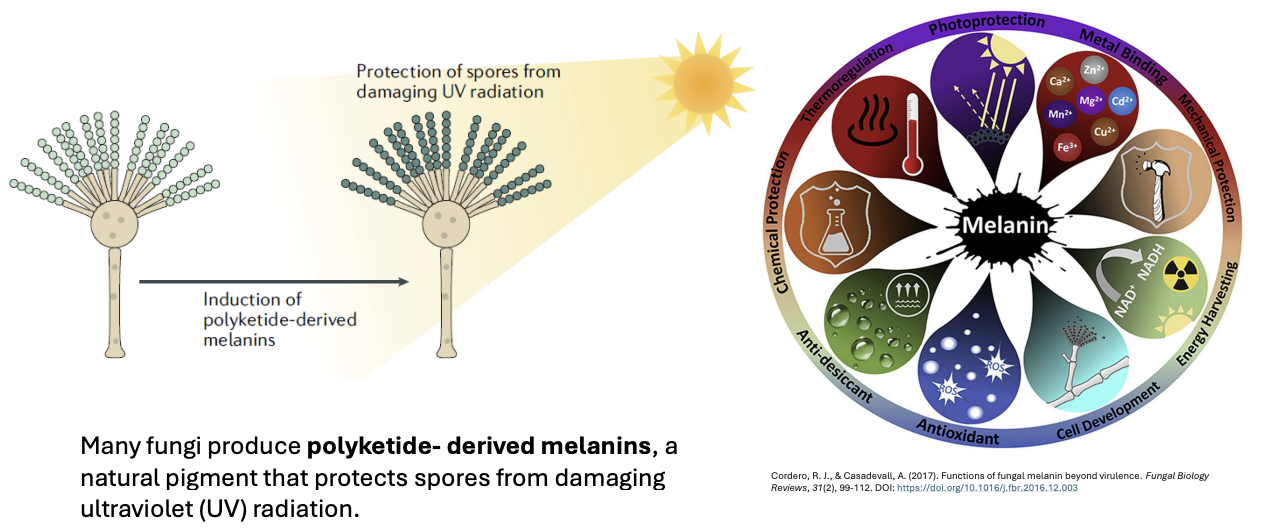
T/F: Melanin functions beyond virulence, extending to photoprotection, metal binding, mechanical protection, energy harvesting, cell development, antioxidant, anti-desiccant, chemical protection, thermoregulation
TRUE
T/F: Melanins can be used for metal-binding to purify certain metals from mixtures of metals
TRUE
Enumerate examples of secondary metabolites’ role in fungal growth
Polyketide-derived melanins protecting spores from UV-induced mutations
Bikaverin BGC prevent bacterial invasion in Fusarium
Explain how secondary metabolites can protect fungi from bacterial entry and invasion
Bikaverin BGC (biosynthetic gene cluster): what makes secondary metabolites in Fusarium sp.
Such that when Fusarium is invaded by ralsolamycin of Ralstonia solanacearum,
When Bikaverin BGC is off (-), ralsolamycin induces development of chlamydospores that overall allow bacterial entry and invasion
Meanwhile, when bikaverin BGC is on (+), chlamydospore still develops but then pops to prevent ralsolamycin from spreading further into different parts of Fusarium
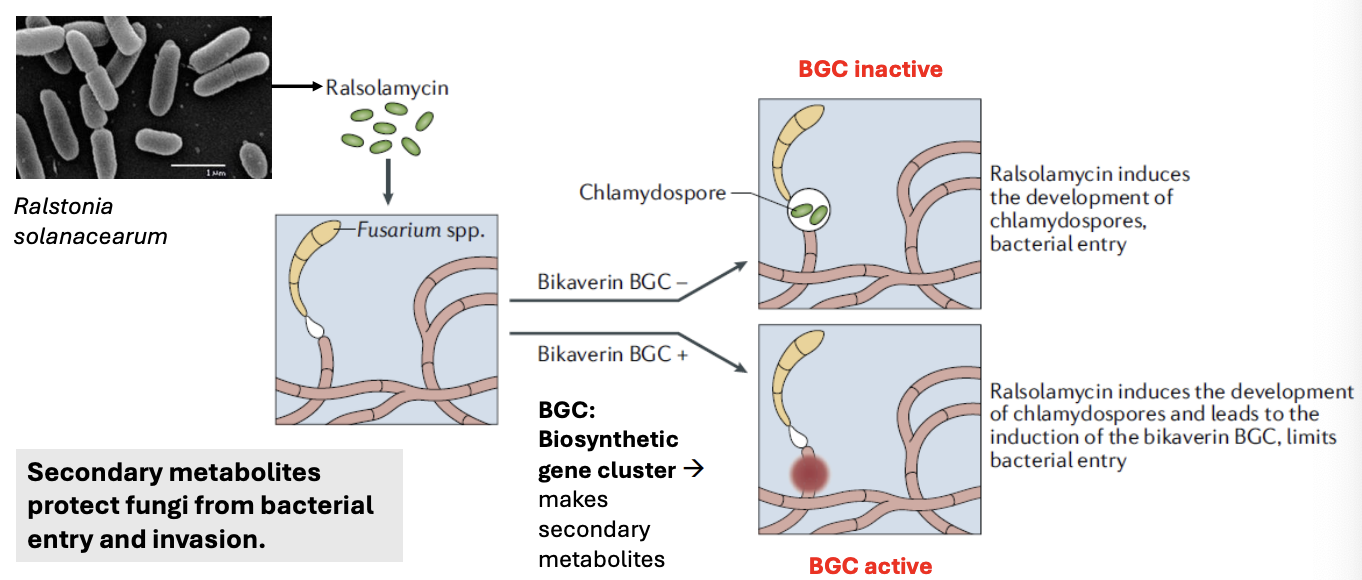
Explain how some secondary metabolites affect developmental processes in fungi
Expression of polyketide synthase affects perithecial (fruiting body/ascocarp) formation in Sordaria macrospora, such that
Deletion of polyketide synthase inhibits perithecial formation; thus fungi have to rely on mitospores (asexual rep)
Meanwhile, overexpression led to malformed spores and fruiting bodies lacking the usual perithecial neck
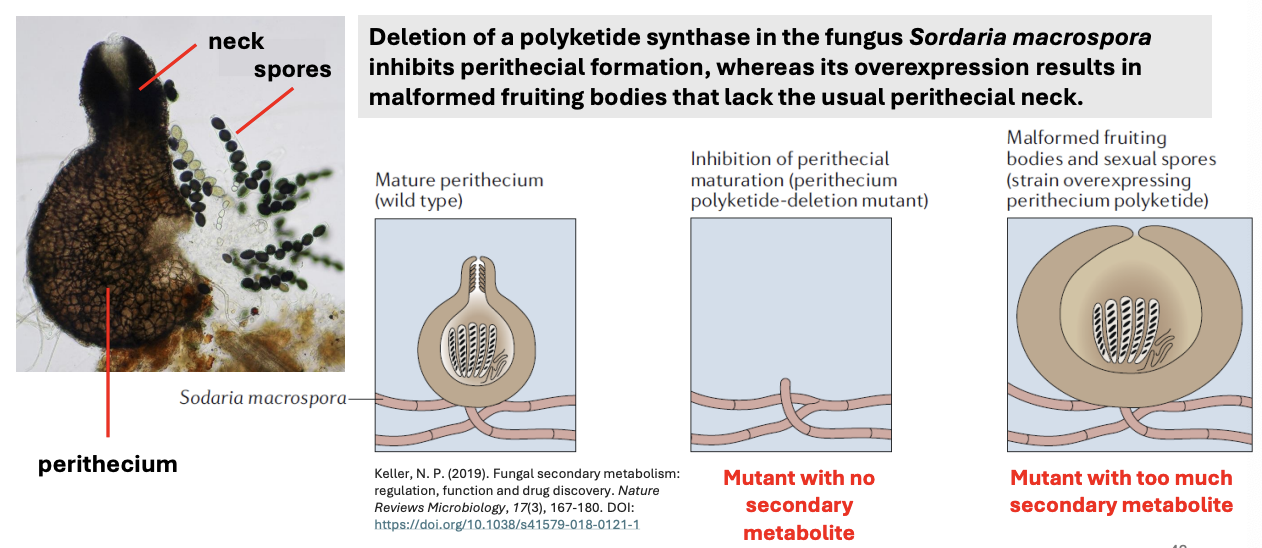
Fungi produce many medically and economically important secondary metabolites, including _
Antibiotics: penicillins, griseofulvin, cephalosporins pgc
Mycotoxins: aflatoxins, ochratoxins, amatoxins, phallotoxins, ergot alkaloids aoape
Antitumorals: patulin, azaphilones, coumarins, lactones, phenols paclp
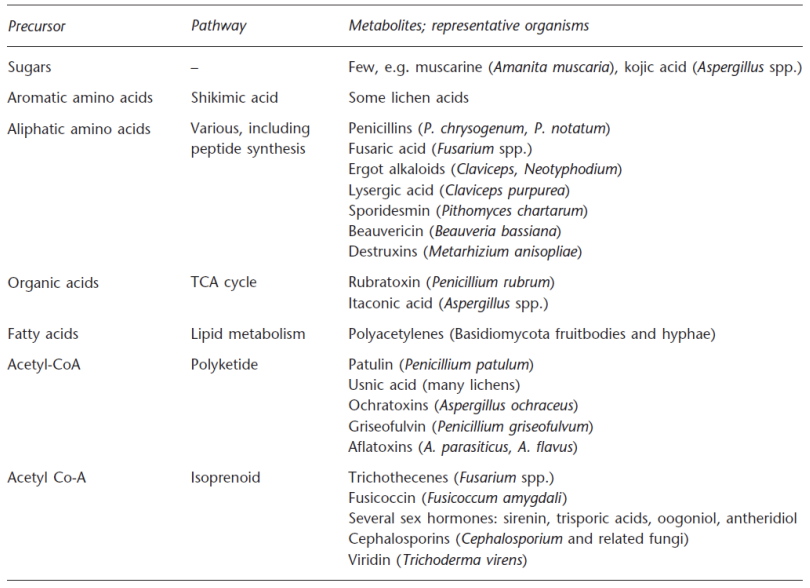
Several biochemical, e.g., _, and environmental factors, e.g., _, affect fungal growth ability
Biochemical = nutrition
Environmental = temperature, O2, water & osmolarity, pH, light towpl
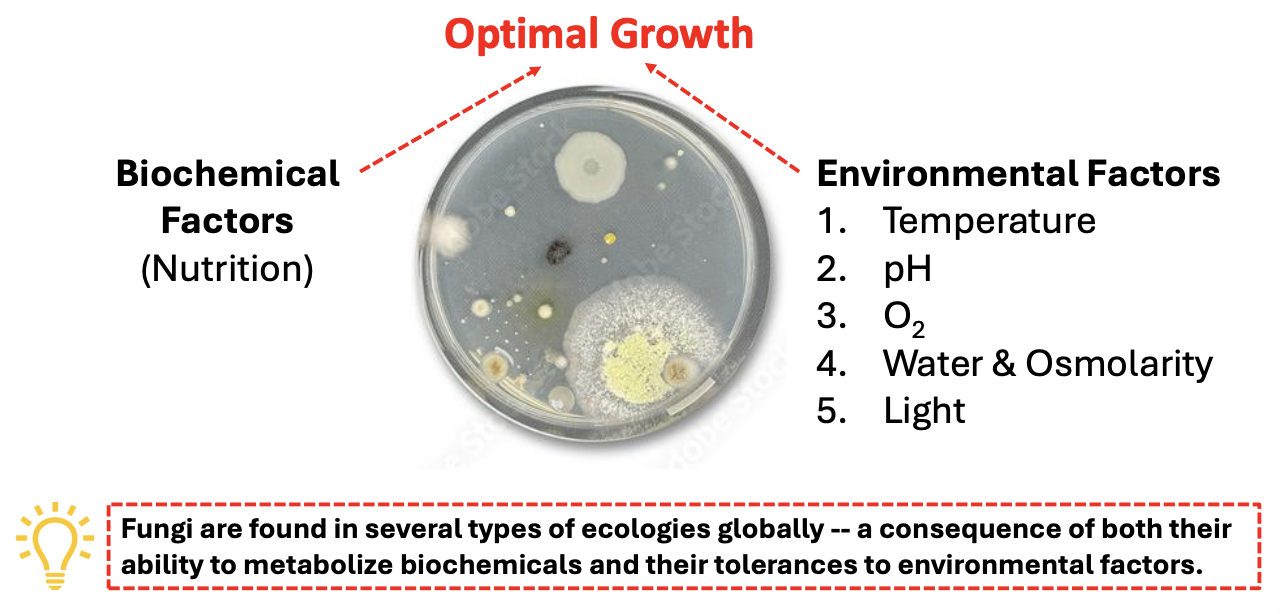
Fungi are found in several types of ecologies globally—a direct consequence of both _
their ability to metabolize biochemicals
their tolerances to environmental factors
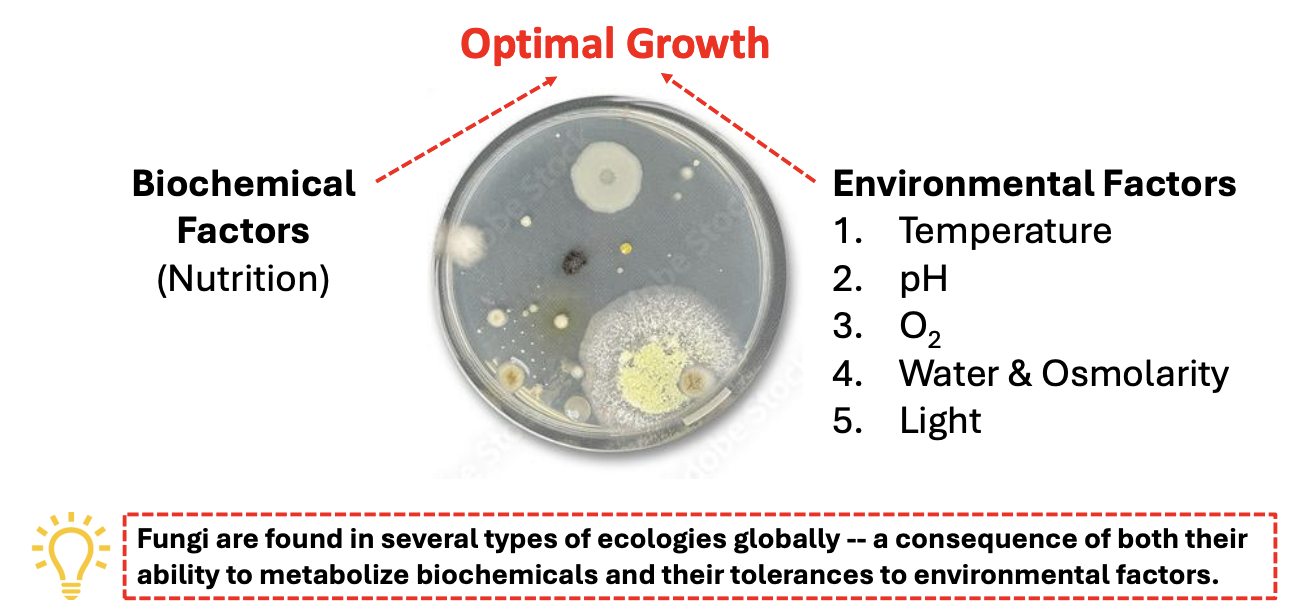
Explain 3 cardinal temperatures impacting fungal growth
Min temp = temp below which growth is not possible
Membrane gelling (rigid), transport processes become so slow that growth cannot occur mt
Optimum = temp at which enzymatic reactions are occurring at maximal possible rate
Reflects a state where all or most cellular components are performing at max rate
Usually closer to max temp than min temp
Max temp = temp above which growth is not possible
Protein denaturation, collapse of cytoplasmic membrane, thermal lysis pct
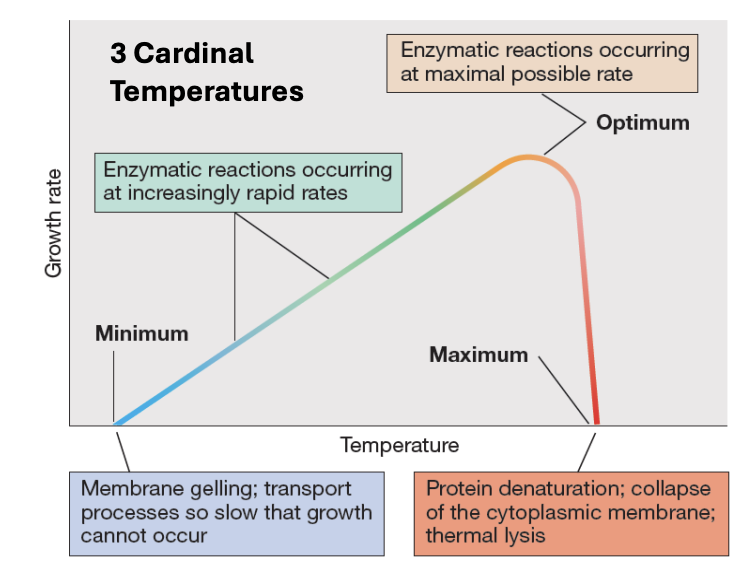
T/F: Optimum temperature typically lies closer to min than to max
FALSE
Optimum temperature typically lies closer to max than to min

There are 4 broad fungal classes in relation to their growth temp optima, including _
Thermophilic = min 20, opt 40-50, max >50
Thermotolerants = min 10-15, opt <40, max 50
Mesophilic (most fungi) = min 10-15, opt 20-30, max 40
Psychrophilic = min - to 5, opt < 16, max 20
Fungal class based on growth temp optima
Min 10-15, opt 20-30, max 40
Mesophilic
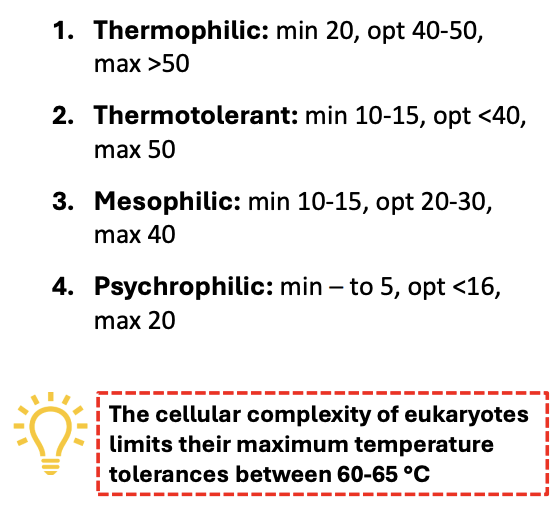
Fungal class based on growth temp optima
Min 10-15, opt < 40, max 50
Thermotolerant
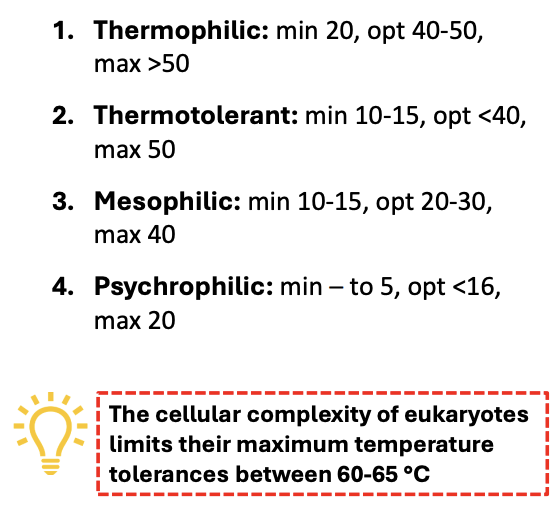
Fungal class based on growth temp optima
Min - to 5, opt <16, max 20
Psychrophilic

Fungal class based on growth temp optima
Min 20, opt 40-50, max >50
Thermophilic

The cellular complexity of eukaryotes limits their max temperature tolerance to _
60-65 C
Enumerate correlates, compounds + structures, mechanisms relating to fungal heat tolerance
Correlates gfwg
Geography
Fermentation
Water retention
Growth substrate
antifungal resistance, phylum & climate
Compounds + structures pth
Pigments
Trehalose
Heat-shock proteins
Mechanisms ttd
Transpiration (evaporative cooling)
Thermal priming
Directed evolution
Thermal dimorphism
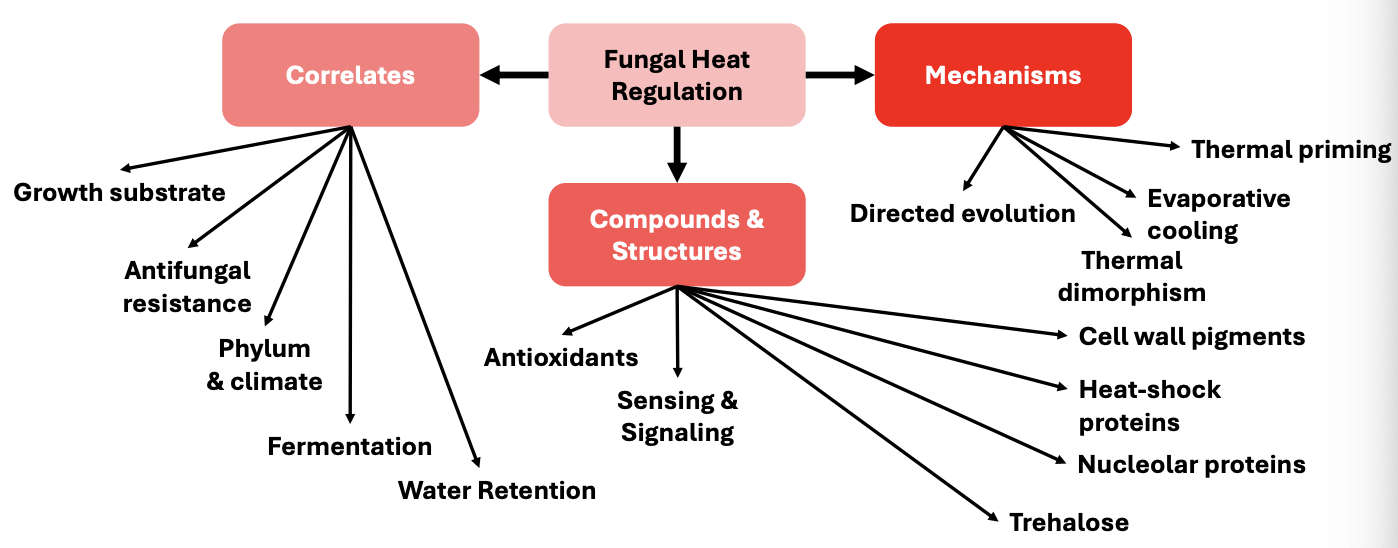
_ are fungal characteristics that are associated but not necessarily causative of certain fungal traits, e.g., thermotolerance
Correlates
Thermotolerance is a _ trait, emerging through different phyla, genera, and even fungal strains (no common ancestor), which could imply that it might have evolved as consequence of geography
Polyphyletic (convergent)
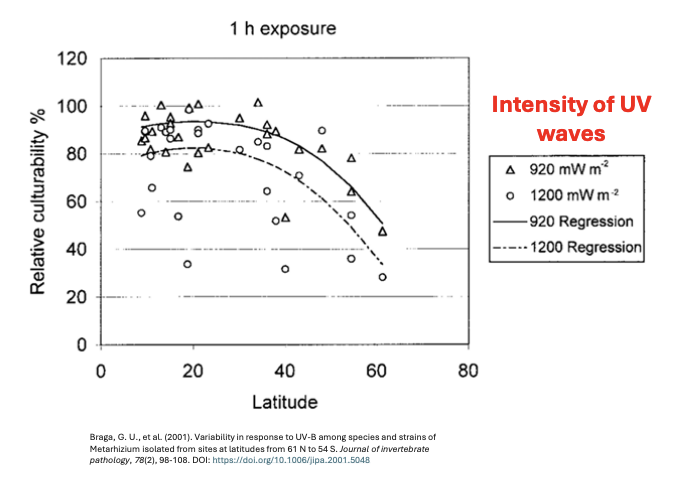
Explain why geography is considered a heat tolerance correlate
Thermotolerance = polyphyletic trait emerging thru diff phyla, genera, strains
Fungi closer to the equator are more thermotolerant, and photoprotection than those at opposite poles
As latitude increases (goes nearer to poles), UV tolerance becomes lower
Latitude and exposure of fungi to heat correlate with thermotolerance
Makes sense bc those exposed to higher temps more would have more need to develop higher heat tolerance than those living in colder temps
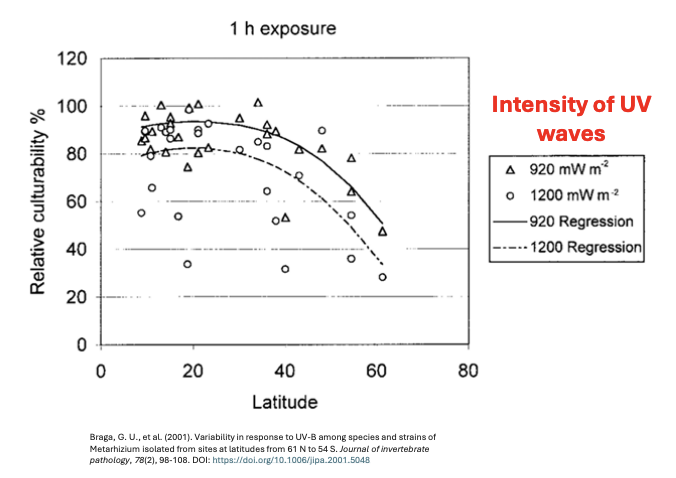
Explain why fermentation is considered a heat tolerance correlate
Fermentation is a heat-releasing process; the faster the fermentation (for simple sugars), the more heat is released; the slower the fermentation (for complex sugars), the less heat is released → affects tolerance
Glycerol = sugar alcohol that has anti-denaturation effect on proteins
When they compared glycerol concentration of wild type vs. thermotolerant yeast strains, they saw that glycerol was produced in higher concentrations and at much faster rates by thermotolerant strains than wild-type, indicating that fermentative strains possess heat tolerance and/or glycerol-induced protein protection
Makes sense bc fermentative strains are exposed to heat a lot and thus should be adapted to it
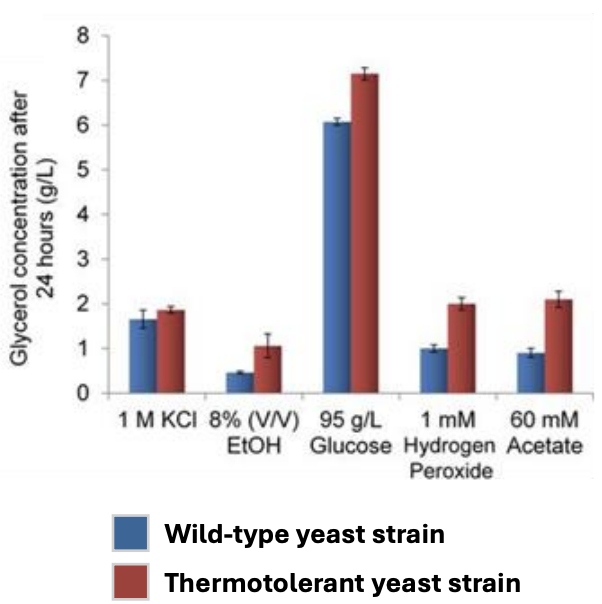
Explain why water retention is considered a heat tolerance correlate
Water has high specific heat / high heat capacity and thus organisms that retain it will be more thermotolerant
Fungi that produce hydrophobic conidia (i.e., have waterproofing qualities → cuticle) retain water more and thus are more heat tolerance
When they compared growth of B. bassiana (which produce hydrophobic conidia) and S. lano (hydrophilic conidia) under 45 wet heat, mean germination% immediately fluctuated in nonhydrophobic; higher survivability in fungi with hydrophobic conidia
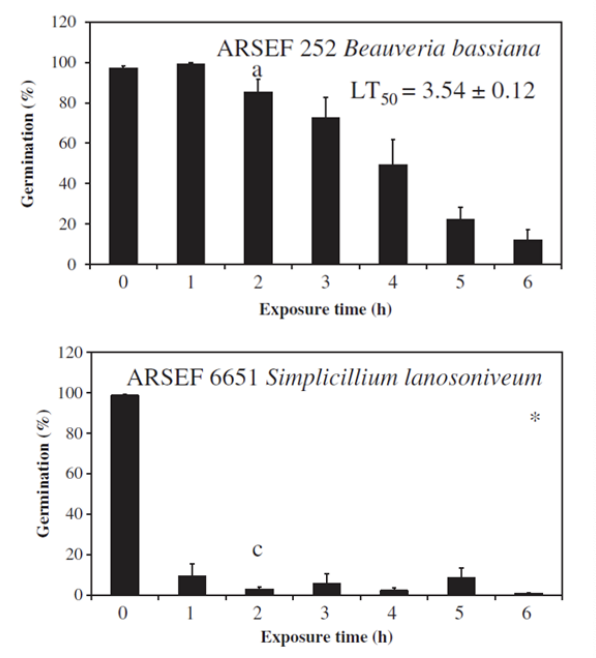
Explain why growth substrate is considered a heat tolerance correlate
Growth substrate fungus uses to grow can trigger thermotolerance
psn
Pigmentation: substrate type can determine presence of pigment precursors
Salts: + of NaCl, KCl reduce water activity and water retention, leading to lower thermotolerance
Nutritive stress can trigger cross-protection by activating heat-shock response
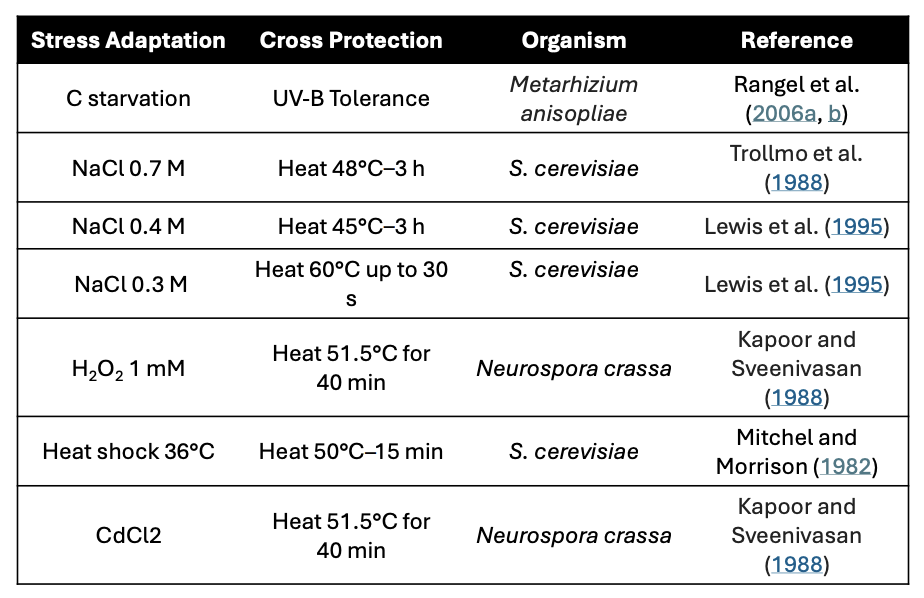
T/F: Exposure to damaging temperatures after extended periods of priming are effective, suggesting cellular memory for thermal priming
FALSE
Exposure to damaging temperatures after extended periods of priming are not effective, suggesting cellular memory for thermal priming
T/F: The cross protection that occurs due to nutritive stress may be because the pathways that are needed to mitigate both stresses are tied together
TRUE
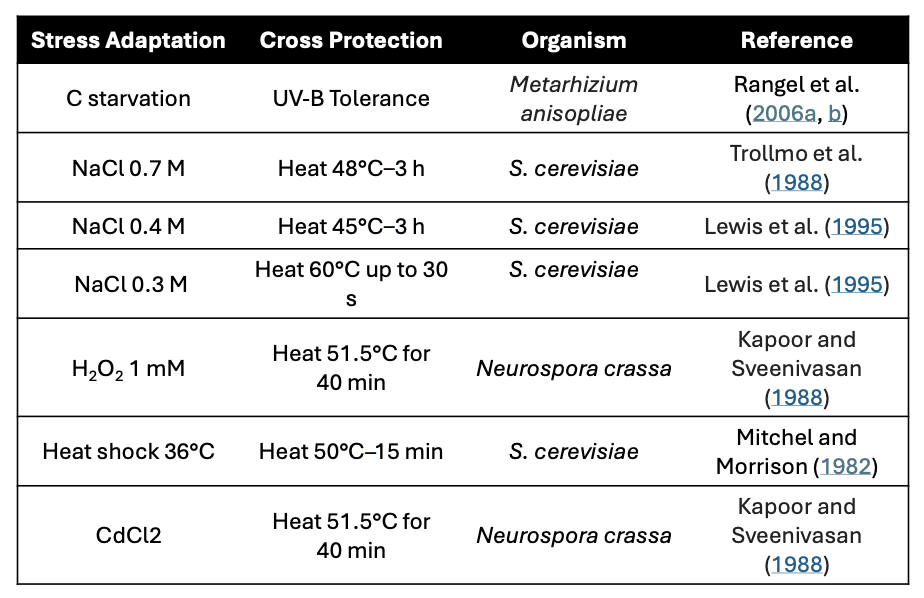
Enumerate and explain 3 compounds & structures affect fungal heat tolerance
pth
Pigments: produced differently depending on genetics, growth substrate, geography
Trehalose: sugar isomer of maltose that forms H bonds with phospholipids, preventing denaturation of proteins + stabilizing membrane under heat stress
Heat-shock proteins (HSP60-like protein complex): prevent misfolding of proteins under heat stress, ensure proper folding
ATP-powered
*Compounds and structures include specific organelles that provide protection and/or stability in response to temperature stress
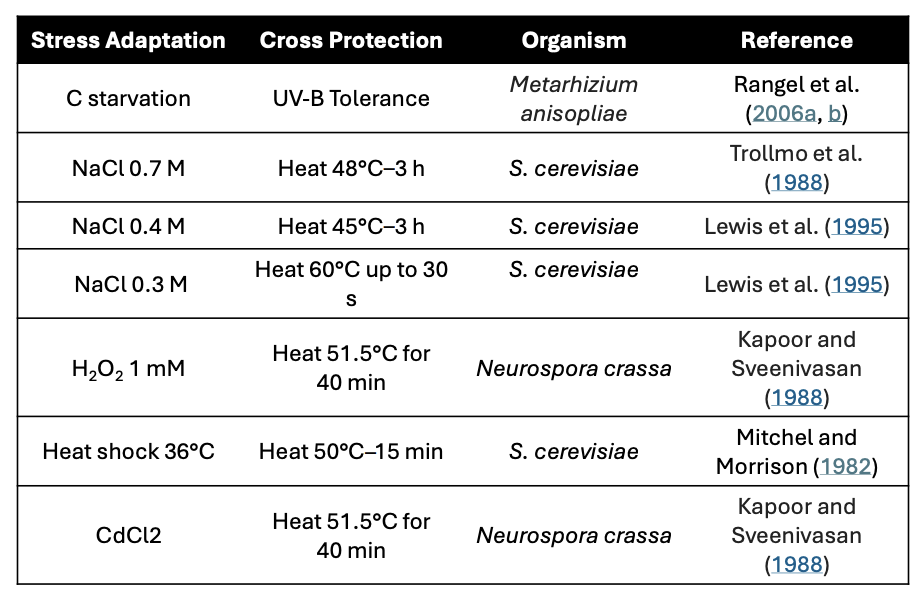
Explain transpiration or evaporative cooling as heat tolerance mechanism
Transpiration (evaporative cooling): using water vaporization to dissipate heat
Mechanisms: include physical and/or chemical processes that work together to thermoregulate fungal organism whether thru heat absorption or directed evolution
As water, which has high heat of vaporization, evaporates, it consumes a significant amount of thermal energy that cools its surroundings
Visible & thermal images of Pleurotus during fruiting while still attached to substrate; achieved lowest temp = 13.1 C at 4d

T/F: Fungi would always maintain an internal body temperature lower than that of the external environment
TRUE

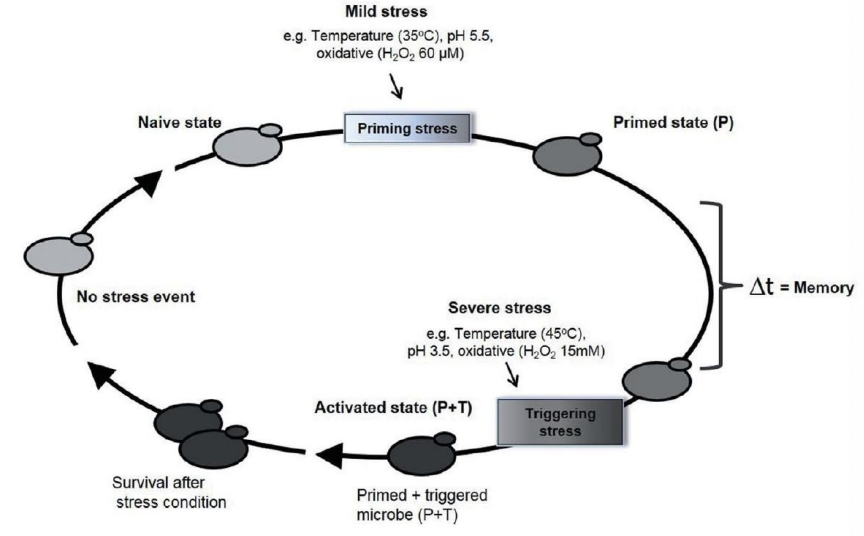
Fungal thermotolerance can be learned or acquired through _
temperature / thermal priming
T/F: Fungi in terrestrial environments would likely employ transpiration as heat tolerance mechanism than fungi in aquatic environments
TRUE
_ refers to heat tolerance mechanism wherein exposure to slightly higher temperature allows fungus to develop resistance to elevated and damaging temperatures
Thermal priming
Exposure to damaging temperatures after extended periods of priming are not effective, suggesting _ for thermal priming
cellular memory
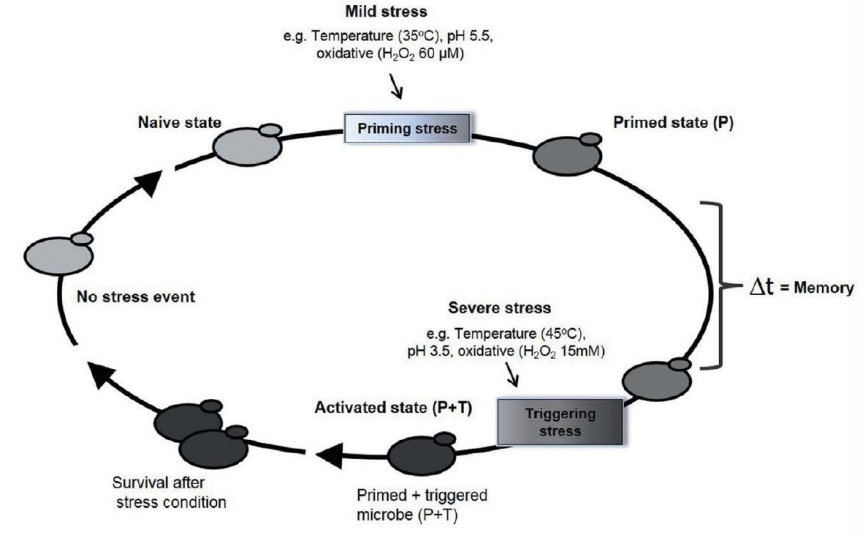
Explain thermal priming as heat tolerance mechanism
Fungi in naive state is exposed to mild stress (temp outside mesophilic range)
They survive, entering primed state
At primed state, when they’re exposed to triggering stress, they end up not being too stressed
Enters activated state (P+T) with changed amounts of transcription factors, enzymes, etc (increased stress resistance)
Priming + Triggering
Lasts for a finite period of time; for this to be effective, priming must be close to event of triggering stress (maybe days or weeks but not months/yrs)
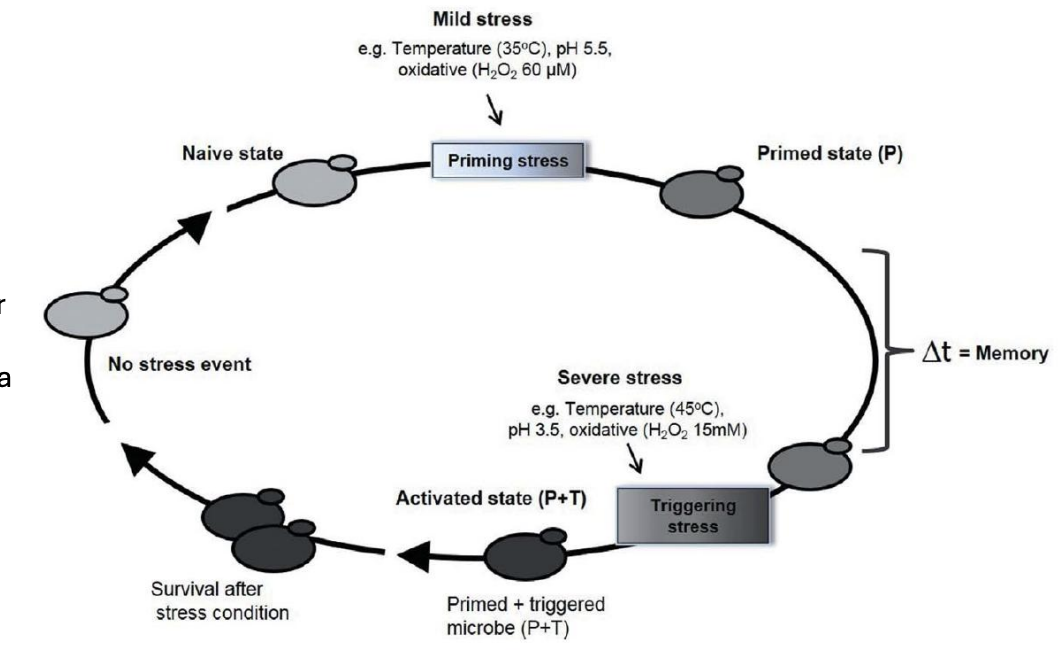
T/F: Microbes with longer memory can survive repeated stress exposures better than those with shorter memory
TRUE
There are many strategies that can induce thermotolerance for artificial selection (directed evolution), including _
Mutagenesis: inducing random genetic mutations using mutagens (e.g., ethyl methanesulfonate EMS, UV)
e.g., exposing yeast to UV light to induce mutations and then selecting heat-tolerant mutants
Hybridization: selective breeding/mating of thermotolerant strains
e.g., Cross-breeding different yeast strains with partial heat resistance to produce more resilient hybrids
Protoplasmic fusion: hybridizing cells asexually without the need for mating
e.g., Fusing yeast protoplasts from a heat-resistant and a high-yield strain to combine both traits
Cytoduction: transferring cytoplasmically inherited traits
e.g., Transferring heat-resistant mitochondria from one yeast strain to another
e.g., concentration of transcription factors
Transfer non-genes
Evolutionary engineering: a population of cells is grown under continuous selection for phenotype of interest for many generations (cell divisions)
e.g., Growing yeast at gradually increasing temperatures for many generations until only heat-adapted strains persist
Genetic modification: modifying or inserting GOI
e.g., Inserting a heat shock protein gene from a thermophilic bacterium into yeast
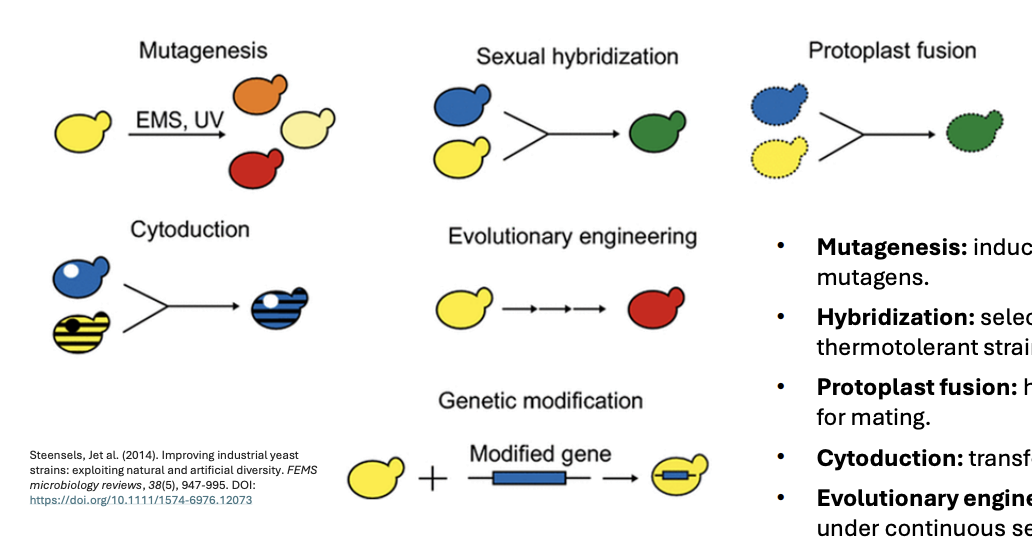
T/F: Protoplasmic fusion is naturally more useful for Dikarya than other fungi
TRUE
Bc they naturally transition into a dikaryotic stage, where 2 genetically distinct nuclei coexist in the same cell before nuclear fusion (genetic recombination)
Enumerate correlates, compounds + structures, mechanisms relating to fungal heat tolerance
Correlates ccs
Cold avoidance
Spores
Sterile mycelia
Compounds + structures ppa
Pigments
Polyols + trehalose
Antifreeze
Mechanisms es
EPS secretion
Symbiosis
Fungi in cold environments have _ hyphal phases and use _ for recolonization
Short hyphal phases
Spores for recolonization
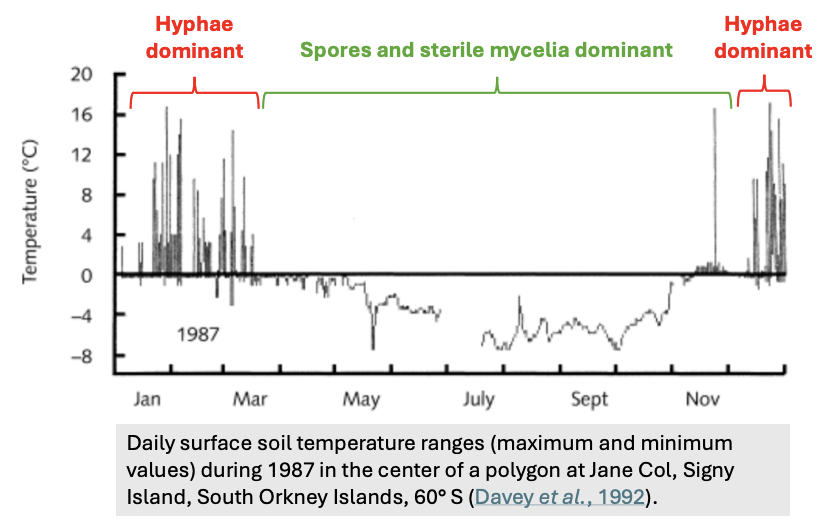
Explain cold avoidance as cold tolerance correlates
Cold avoidance = mechanism of spore production used as reservoir for recolonization during favorable temperatures
Spores can survive the cold; some spores dispersed from warmer climates re-established fungal presence
Sterile mycelia do not produce spores but instead grow using hyphal fragments
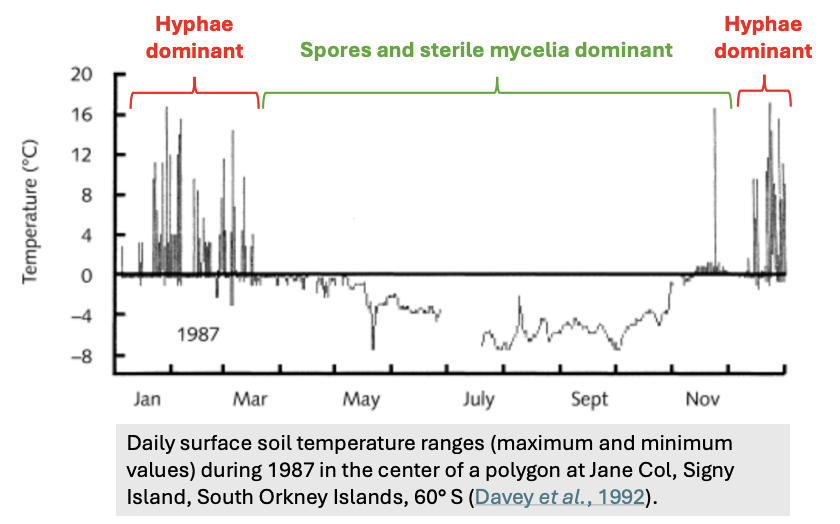
Explain 3 compounds + structures for cold tolerance
ppa
Pigments: darker melanized spores and hyphae can absorb more light and thus generate heat
Polyols + trehalose: sugar alcohols + trehalose accumulate in cells, depressing freezing point and preventing cytoplasmic freezing
Antifreeze: intra- & extracellular proteins slow ice formation by restricting size
Restricts ice crystal formation; controls size small enough to not break open cell
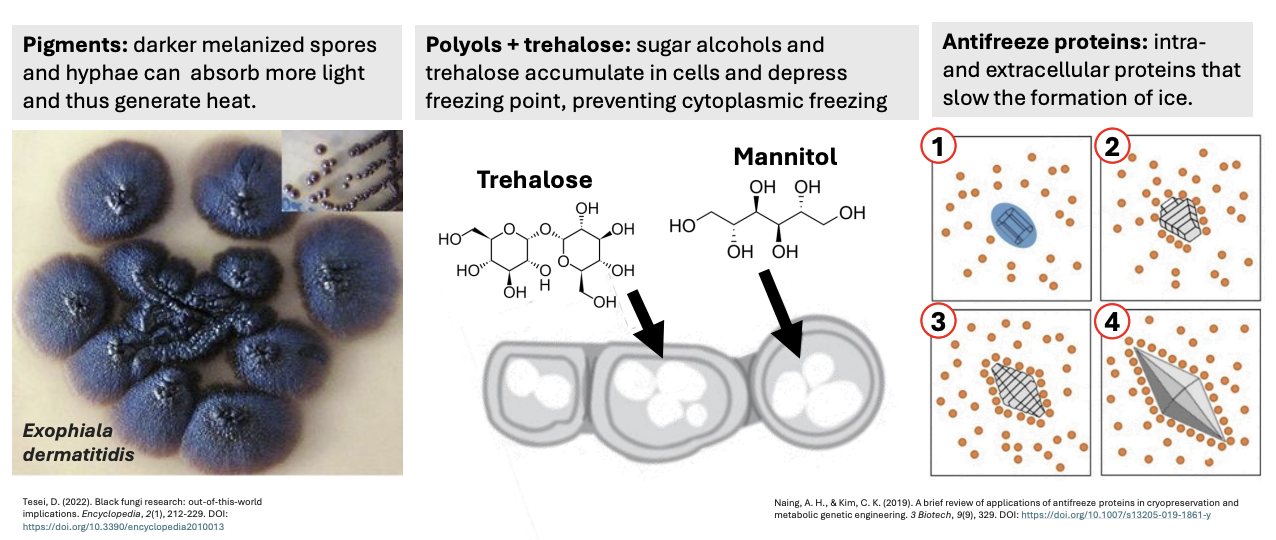
Explain 2 mechanisms for cold tolerance
EPS secretion
Some fungi produce extrapolymeric substances involved in protection against cycles of desiccation, thawing, freezing
e.g., Phoma herbarum, Nothophoma anigozanthi
Symbiosis
Many fungi in cold environments form endophytic, parasitic, ectomycorrhizal associations to diminish impact of cold
e.g., Dothideomycetes = endophytes
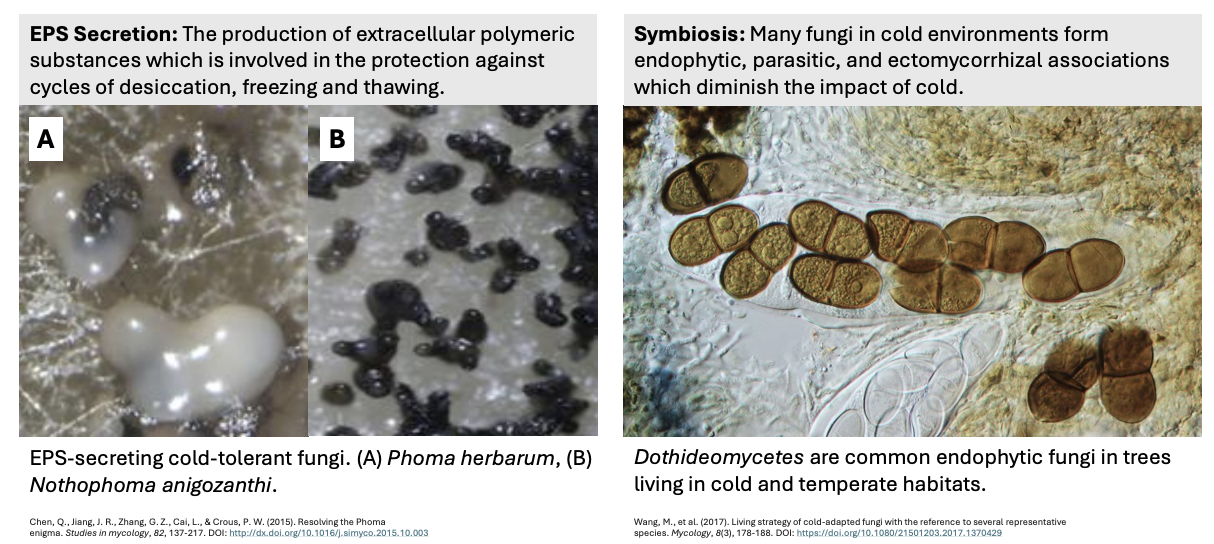
Many fungi in cold environments form _ associations to diminish impact of cold
endophytic, parasitic, ectomycorrhizal
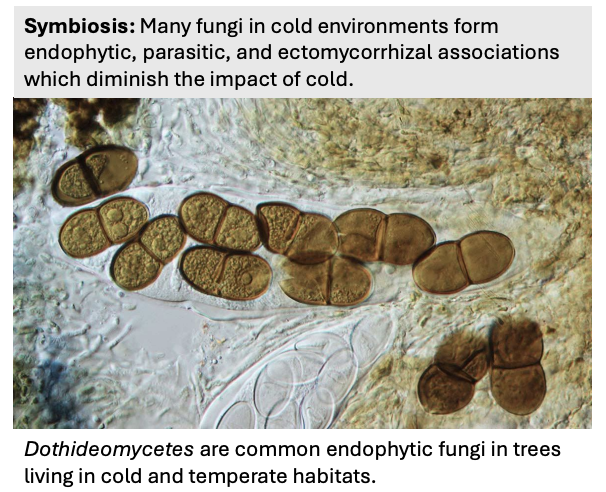
_ expressed as pH, which represents the concentration of H+ and OH- in a solution
acidity or alkalinity
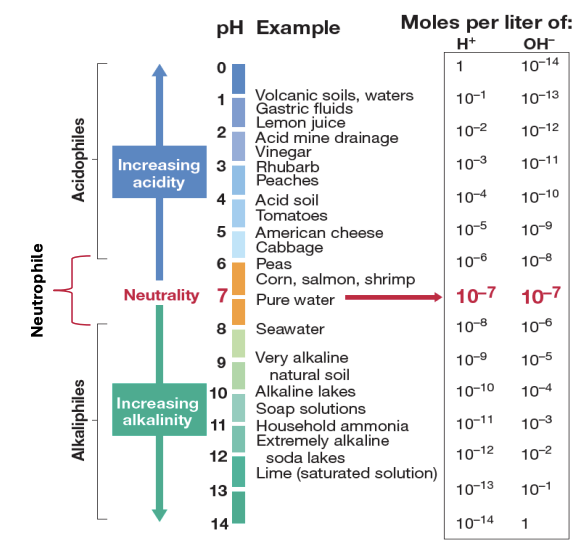
Fungi can quickly turn media acidic due to _
selective uptake or ion exchange, secretion of organic acids, which are important for nutrient solubilization & uptake
Changes in pH can potentially affect virtually all cellular processes, including _
mm cm sc
Metabolism
Membrane potential
Cell growth
Movement of substances across the surface membrane
State of polymerization of cytoskeleton
Cell division
*All use proteins, which denature under extreme pH
Most fungi are mesophilic, growing at pH range _ and have broad pH optima of about _
3.0 - 9.0
Acidophile < 3
Alkaliphile > 9
5.0 - 7.0 pH optima
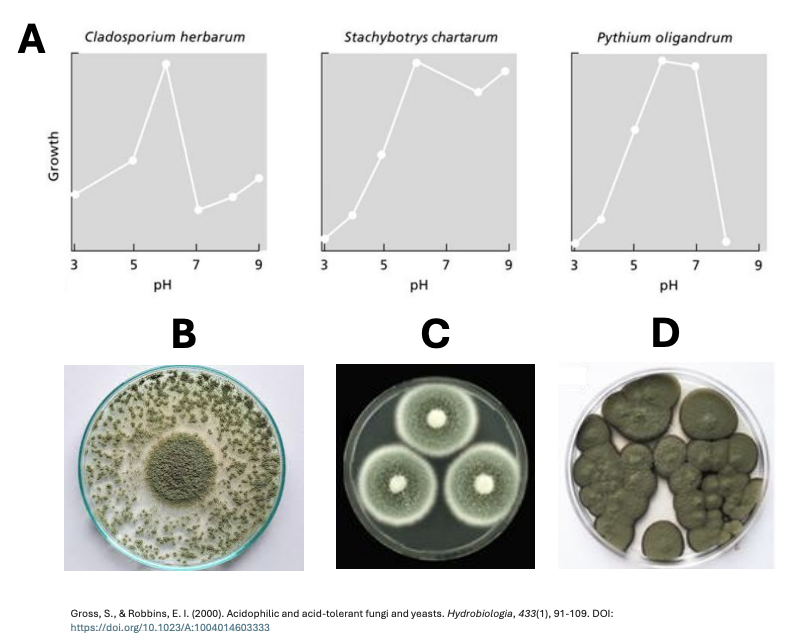
Explain figure
Acidophilic fungi pH optima = 1.0 - 2.0
Many yeasts, some filamentous
fungi such Acontium velatum (pH 0.2-0.7) and
Talaromyces wortmannii ( pH 1.7-1.0).
Alkali-tolerant = pH 10 - 11
Cladosporium, Fusarium, and Penicillium
T/F: There are more acidophilic fungus than alkaliphilic because there are more acidic environments
TRUE
Fungi can use various physiological mechanisms to maintain desirable pH, including _
Cell wall remodeling
Membrane asymmetry
Proton pumps
ATP-binding casette transports
Intracellular pH homeostasis
Production of organic acids
Gene transcription changes
T/F: pH tolerant fungi can change aspects of their cell wall in response to pH stress
TRUE
Explain cell wall remodeling as pH tolerance mechanism
When pH is acidic or basic, the fungal cell wall is remodeled:
Chitin = increases its thickness to form stress barrier
Glucans = unmask themselves to provide buffer zone against acid damage
lessens damage to chitin
Wall enzymes = increase/decrease H+ uptake or efflux
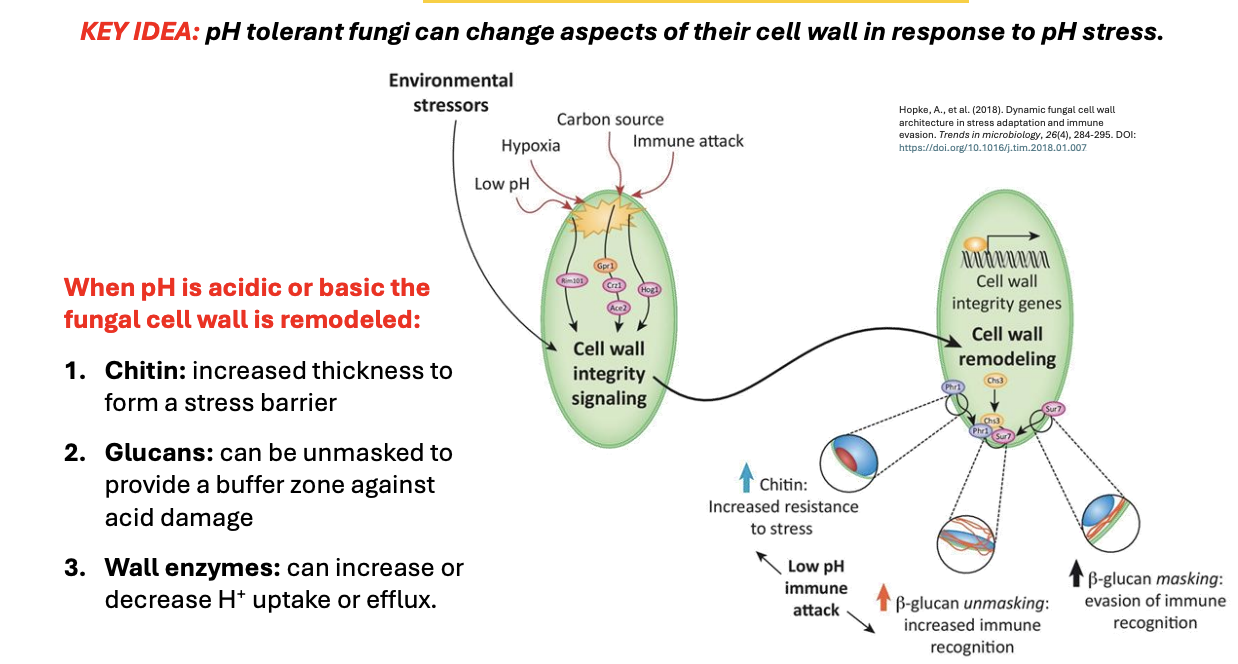
Explain membrane asymmetry as pH tolerance mechanism
Under acidity stress
P-type ATPases & ABC transporters (flippases) reduce phosphatidylinositol (-) in exoplasmic phase and replace this with phosphatidylcholine (+) and thus will retard H+ ions
Under alkalinity stress
Translocase (flippases) will translocate sphingolipids (-) to exoplasmic phase to retard OH- anions
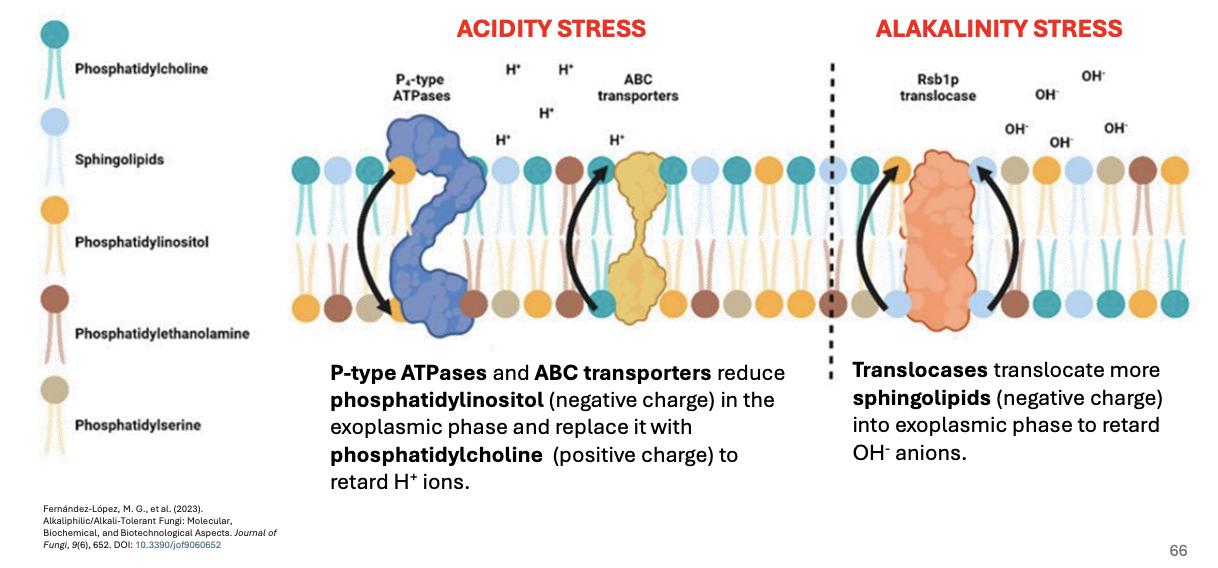
T/F: Phosphatidylserine should be kept in inner leaflet of cell membrane because flipping it to outside signals cell death
TRUE
Attracts calcium > phosphatidyl signal
Explain pH tolerance: how acidophilic fungus promote prey digestion in plants
Acrodontium fungus grows and sporulates on sundew glands (secreted mucilage = acidic) as its preferred acidic environment
Fungal presence increases prey digestion process by causing plant to secrete peptidases
*Carnivorous plants get nitrogen from proteins of living organisms due to limited N in soil
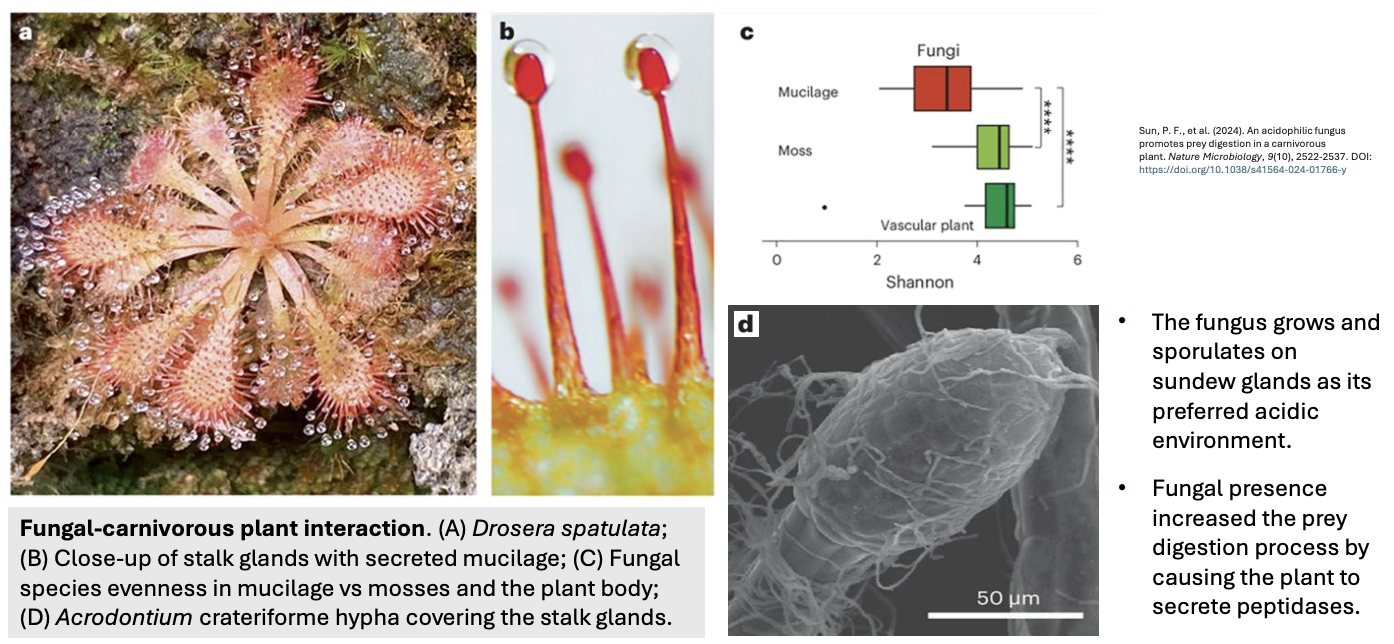
T/F: There’s higher diversity of fungi associated with mucilage compared to those with moss and those with vascular plants near sundew
TRUE
Implying there’s some kind of symbiosis occuring inside plant + fungi > fungal presence increase prey digestion by causing plant to secrete peptidases
T/F: Most fungi are strict aerobes, in the sense that they require oxygen in at least some stages of their life cycle
TRUE
4 main groups of fungi based on their relationship with oxygen
Most fungi are obligate aerobes requiring O2
Many yeasts and mycelial fungi = facultative anaerobes and can perform fermentation
Few aquatic fungi are facultatively fermentative (aerotolerants) bc they lack mitochondria or cytochromes
Few are obligately anaerobic Chytrids in rumen of animals
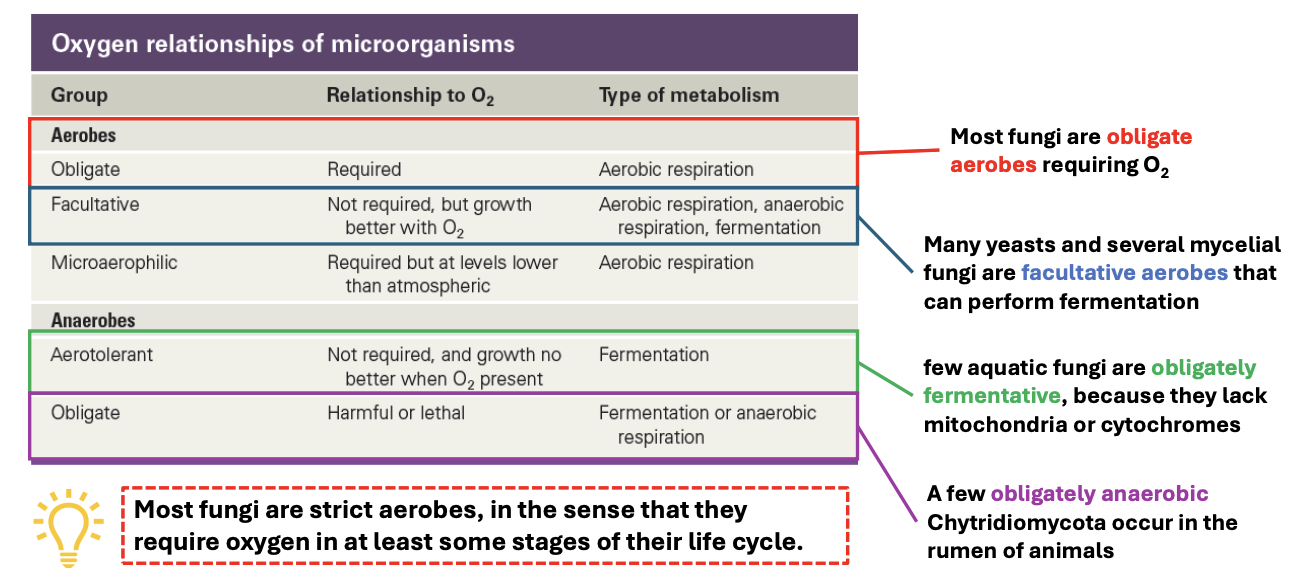
_ are highly variable organelles that evolved from protomitochondria to produce molecular hydrogen and ATP in anaerobic conditions; mixed acid fermentation allows survival
Hydrogenosomes
Explain mixed acid fermentation in anaerobic Chytrids
Glu → Pyruvate → Acetyl CoA → TCA
Malate → [hydrogenosomes]
Malate → Pyruvate → Acetyl CoA → Acetate
→ acetate
→ formate
→ lactate (cytosol)
![<ul><li><p>Glu → Pyruvate → Acetyl CoA → TCA</p></li><li><p>Malate → [hydrogenosomes]</p></li><li><p>Malate → Pyruvate → Acetyl CoA → Acetate </p><ul><li><p>→ <strong>acetate</strong></p></li><li><p><strong>→ formate</strong></p></li><li><p><strong>→ lactate </strong>(cytosol)</p></li></ul></li></ul><p></p>](https://knowt-user-attachments.s3.amazonaws.com/98cdd986-2932-4e25-96f4-098d4de07441.png)
T/F: Fungi need water, and the availability of water differs due to external forces
TRUE
Explain water (potential) & osmolarity
All fungi need water for nutrient uptake, release of extracellular enzymes, intracellular water for metabolic reactions
Water may be present in environment but still not be available for use because it’s bound by external forces → water potential
Water potential = Ψπ + Ψm + Ψp + Ψg
osmotic potential + matric (H-bond binding forces) + turgor potential + gravimetric potential
At equilibrium = no water loss, free flow of water inside & outside
Inequilibrium → when there’s more water outside → water influx
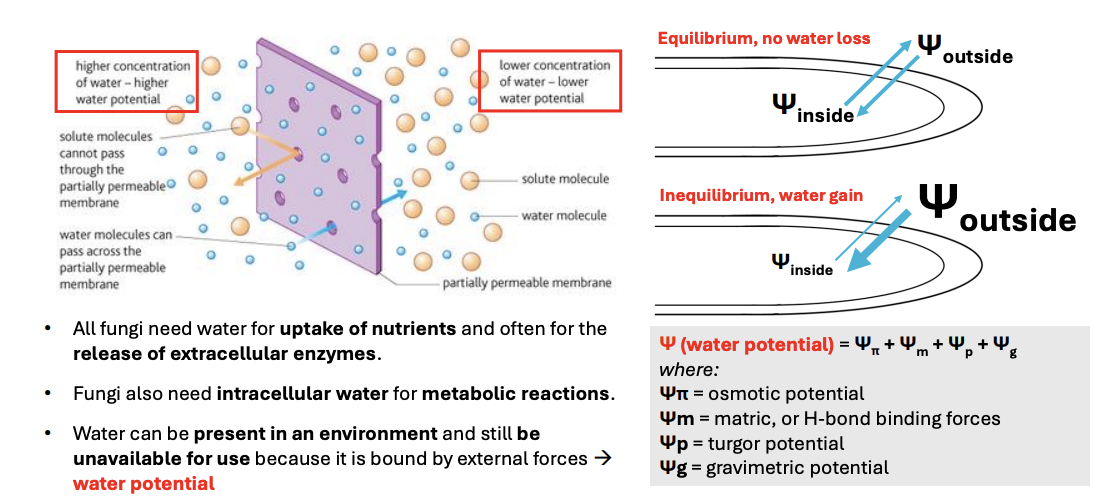
Several traits allow fungi to maintain activity under unusually dry and hot conditions, including
β-1,3-Glucan Synthesis
Water stress inactivates α-1,3-glucan synthase and increases β-1,3-glucan synthase activity to provide more cross polymerization with chitin which provide protection from desiccation by decreasing water loss
Trehalose Accumulation
Increased trehalose substitutes for water
molecules in cell membranes and protects
from desiccation.
It also acts as an osmoprotectant that balances solute concentrations preventing osmotic shock
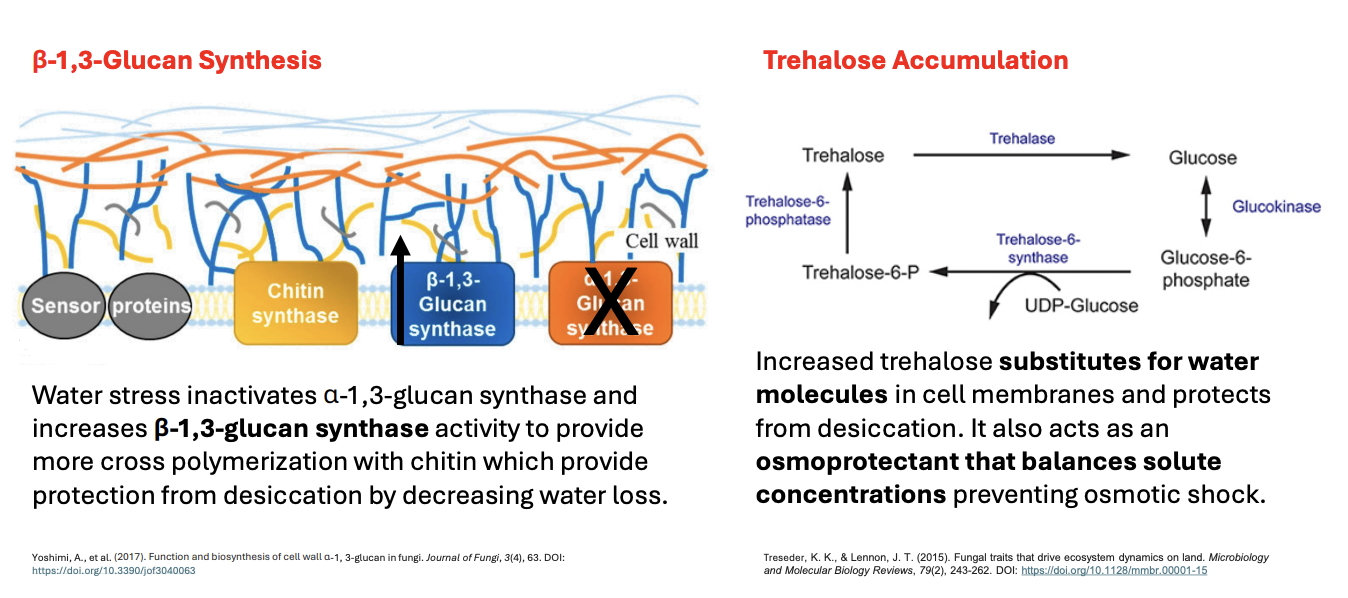
Fungi use a variety of physiological mechanisms to control water potential differences, including
Increasing uptake of ions to generate (-) internal water potential
Increase saturation of membrane lipids to
avoid water loss through increased rigidity
Synthesize compatible solutes (glycerol,
trehalose) to generate more negative internal Ψ
Produce melanized pigments that shield the hyphal tips and spores
Light in near-ultraviolet and visible parts of spectrum (380-720 nm) has relatively little effect on vegetative growth but can stimulate _
pigmentation

What are pigments that may be triggered by light?
Carotenoid = stimulated by blue light, deals with ROS
Melanins = protect against ROS & UV damage

A fungal cell contains three sets of light receptors: _
Red light = phytochromes
Green = opsins
Blue = white collars, vivid, cryptochromes, photolyases
Explain influence of light on different stages of fungal development
sg m bas
Inhibits spore swelling, germination (sporulation)
bc spore has limited energy > cant grow germ tube > hyphae first
Stimulates melanin production
when established > melanin increased
Inhibit branching
more pigments produced > no more resources for branching
Stimulate asexual sporulation (microcycle)
Either stimulate or inhibit sexual fruiting body formation
production of fruiting body > meiospores > opposite mating types > lower chances of finding under
stimulates the fruiting body in the presence of light (species to species), e.g., ballistospores in light → high relative humidity
*generally repress branching, structures, dispersal activities = temperature may not be → high humidity ballistospore > light
